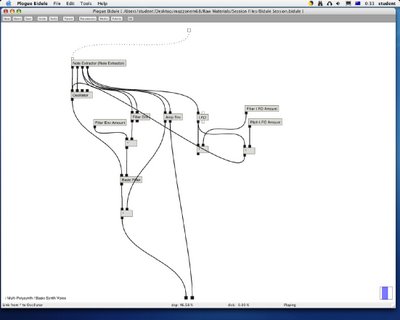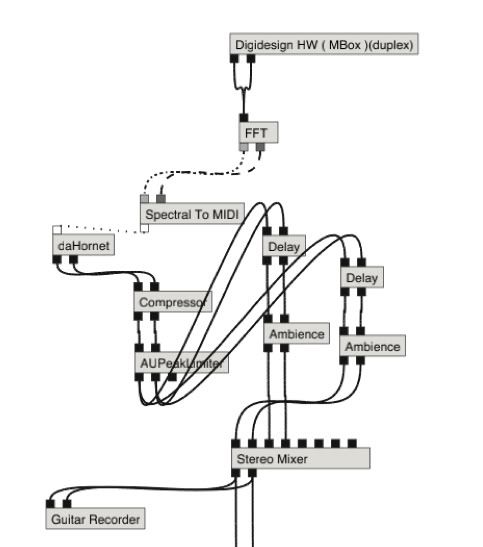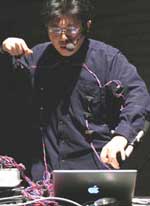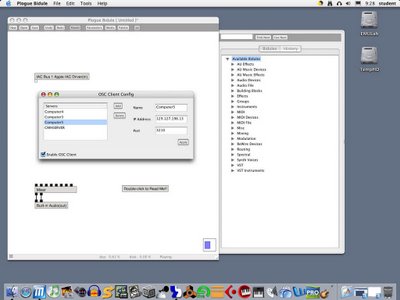Workshop -Improvisation-
Our final session at uni this year was the workshop. This session was a great way to finish off the year. I performed in the second group and I was on the Juno 6 synth. At the beginning of our performance I couldn't hear myself but luckily Ben increase my level on the mixer and away I was creating my awesome arpeggios and filter sweeps.
I had fun but I thought each group may have played too long. Maybe I was just really tired or maybe I was just waiting to finally go home and sleep!
Saturday, November 18, 2006
Creative Computing Major Assignment
For my major assignment this semester I had to compose an electronic piece and perform the piece in real time. I created my sounds in Plogue Bidule and used Live also to trigger off my samples. Bidule ran as the master in this case.
In Bidule I created a number of patches. Below is my piano pad sounds I made.
This is my PolySynth patch.
This is my Multi-Synth patch.
This is my Bidule Session
I created my bass patch using spectral processing. This created a large amount of stress on the CPU usage. The sound was very loud which I was able to fix with a compressor. You can see the compressor in my Bidule session. 
My guitar sound was created by controlling a VSTi. The guitar audio was converted to MIDI using a spectral Bidule. After the plugin, the signal runs through two delays and two ambient plugins.

My Live session had four scenes (the maximum allowable in Lite Edition). 

I have a recording of my live set.
Crazy Piani High Quality [8.5MB]
Crazy Piani Medium Quality [5.7MB]
Crazy Piani Low Quality [2.5MB]
I also have my documentation attached if you want to read.
My Documentation + Samples
Audio Arts Minor Environment Assignment
This semester, I chose to do my Audio Arts as my minor. The assignment was to record a sound scape using a portable recorder. I used the Maranz Firewire recorder instead of the DAT.
We then had to recreate the sound scape by identifying all the sounds, mapping them in a sound event map, recreating them, and then doing a 5.1 surround mix in Cubase. All the sounds had to be created using synthesis or sampling techniques. If we used a sample it had to be a basic sound. In my case I used a recording of paper being blown into.
All my synthesised sounds were created in Plogue Bidule. I recorded my Bidule patches and then imported the audio files into Cubase. I have some pictures of my Bidule patches and my Cubase Session. I also have a stereo mix of my sound scape and recreation.
AA_Minor High Quality (4.5MB)
AA_Minor Low Quality (1.3MB)
Original Soundscape (2.7MB)
Documentation
This is a screenshot of my final result.

These are the patches for my bird sound.

Week 13 Forum [1]
[1]
Today we had guest speaker Johannes Sistermanns. He is an artist from Germany who does Sound Plastic.
During the presentation Johannes claimed that he practiced sound plastic and not sound installations. I don’t understand the difference. I’m not sure if it’s because his English wasn’t the best or if it’s because I just don’t understand what he does. There’s one thing I know for sure, and that is he seems to love cling wrap.  [2]
[2]
Unfortunately he didn’t have any audio to play to us, which I though was a bit strange. It’s pretty difficult to imagine what tons and tons of cling wrap will sound like. I imagine like a gigantic sandwich. As you can see it’s the end of the year and I just want to get this blog finished. [3]
Here are some samples that to make the Johannes experience come alive.
Sample 1 (44KB)
Sample 2 (128KB)
[1] Johannes Sistermanns. "Johannes Sistermanns", http://www.st.rim.or.jp/~mal/Cafe/JSS3.jpg (Accessed November 11th 2006)
[2] Johannes Sistermanns. "Johannes Sistermanns", http://www.rachelhaferkamp.de/images/sistermanns/sister06pics/Gang_DeckeBoden_.jpg (Accessed November 11th 2006)
[3] Johannes Sistermanns. 'Music Technology Forum Presentation - EMU Space'. Lecture presented in the EMU Space, Electronic Music Unit, University of Adelaide, 2nd November 2006.
Week 12 Forum
Today was another improvisation session. David Harris spent some time with us. He was trying to get a 7/8 rhythm going. Seeing as though I struggle with any timing other than 4/4, this was a challenge. After a while I got the hang of it. David played some chords on the piano, which help keep us all together.
I think this improvisation session was not up to scratch like the other weeks. Seeing as though it was just before exam time I think everyone was stressed.
Friday, November 17, 2006
Week 12 Creative Computing
This week I started using the K5000 to control parameters in Bidule. This was really useful. Ben showed me a really quick way of linking the parameters in Bidule to the knobs on the K5000. I utilised this controller a lot in my assignments as it gives you a lot more control and a mouse.
Week 11 Forum
Today we had guest speaker Luke Harrold. It was nice to have a guest speaker for a change. I was lucky to have Luke as my theory lecturer in Certificate IV. I had no idea at the time he was doing a PHD in Music Technology.
He spoke to us about his research overseas. He was in Paris attending this major event called NIME, which stands for “new interfaces for musical expression”. I am going to Paris in December so I might check this out. That’s if my family don’t get too bored.
The best part of Luke’s presentation was a movie he showed us of a live Japanese performer Adachi Tomomi. He had all these senses attached to different parts of his body in such a way that movement would set them off. He was creating music using his body movements. Well I don’t know if you can call it music. The actual sound got annoying after a while. The idea though was really interesting and I can definitely see this concept being used in many avenues of entertainment in the future. [1] [2] Finger movements
[2] Finger movements
 [3] Good to see him using a real computer.
[3] Good to see him using a real computer.
[1] Luke Harrold. 'Music Technology Forum Presentation - EMU Space'. Lecture presented in the EMU Space, Electronic Music Unit, University of Adelaide, 19th October 2006.
[2] Dream Train Internet. “Adachi Tomomi?”, http://www.purple.dti.ne.jp/naya/contens/img/adachi3-2web.jpg (Accessed 11th November 2006)
[3] Dream Train Internet. “Adachi Tomomi?”, http://www.h5.dion.ne.jp/~olounge/ido062/062photo/adachi.jpg
(Accessed 11th November 2006)
Week 11 Audio Arts
This week we had to created a doppler effect. This wasn't too hard. Once again, sorry for the small picture.
Doppler Effect [221KB]
Week 10 Forum
Today’s forum was guess what... Improvisation. I though that an entire two hours of improvisation would have dragged on a bit. Turns out we pull some great sounds. I was on the Juno synth and I selected my sounds on the MIDI sound module in the rack (of Studio 5). I wish I could select my sounds quicker without having to always refer to the sound module. Still, the sounds are quite good.
I do prefer playing off a computer because I can control the parameters of the synthesisers in real time. The synths in Reason are better to use because I can shape the sound and change patches really easily.
The improvisation session was good my only criticism is the dodgy speakers in Studio 5. There’s no bass!
Week 10 Creative Computing
This week I have to rewire Bidule and Reason together. The picture is really small and I don't know how to fix it. Sorry.
Bidule & Reason Connectivity [312KB]
Week 10 - AA - Spectral Water
This is my water sound using spectral processing in Bidule. I think the end result sounds okay.
Water Sound [280KB]
Week 9 Forum - Improvisation Group 3
Today was my week for the improvisation session. And what a session it was. I was luckily enough to improvise with Tyson Hopprich or better known as DJ Tr!p. This two hour session was my highlight of the year for me. Being a DJ myself, it was really great to be able to talk to DJ Tr!p about the industry and the music he is producing and has produced. Who knows, maybe in 10 years I will be taking an improvisation session!
I got there early to check out the setup and have a chat to DJ Tr!p. He was using a CD turntable connected to a DJ mixer and also a laptop running Fruity Loops. He also had a Gameboy Advanced connected to one of the inputs of the mixer. The Gameboy had a Gamboy Camera attached to it. He was incorporating the basic 8-bit sounds from the Gameboy into his mixing.
When everyone arrived he gave an awesome demo. He mixed the drum loops from Fruity Loops to the beats from his Gameboy. My “trained” ear could hear when the beats were slightly going out of time but DJ Tr!p was quick to correct them. He also scratched some samples using the CD turntable.
I have never seen this kind of experimentation before in DJs, and I really want to start doing this myself. I have a Gameboy Advanced at home so don’t be surprised if you catch me in a club pulling out some Super Mario tunes!
Our improvisation session went awesomely (is that a word?). I was on the piano and my plan of attack was to first figure out was key we were in. Then I would play the chords and play any note I think sounded good (I suppose that’s what improvisation is anyway). We did three takes and they all sounded pretty good. I swapped with Dragos on the last take and I was on the Juno Synth. I actually found this harder to perform with because my sound didn’t go with everyone else and I didn’t have time to flick through patches. Still I just had fun watching DJ Tr!p do his thang.
Overall today was just awesome and I really hope we have this kind of exposure in future forums. [1]
[1] The Awesome DJ Tr!p. 'Music Technology Forum Improvisation Session - EMU Space'. Lecture presented in the EMU Space, Electronic Music Unit, University of Adelaide, 21th September 2006.
Saturday, November 11, 2006
Week 8 Forum - Improvisation Group 2
Today we had our second group do their improvisation session. Our guest today was Dr. Chandrakant Sardeshmukh (we should call him Dr. Sard for short). I though this improvisation session was really amazing. I loved the music and by the end of the session I was lying on the floor in a semi-sleep state. That wasn't because I found the music boring. In fact, it was quite the opposite. I found the music really relaxing and I could have easily fallen asleep. I think I did for a short time.
When the music ended I wanted it to go for longer and I wish someone recorded this improvisation session. One thing that the doc showed us which I though was really interesting was his scales. In India the major scale is in fact what we would call the Lydian mode. So the forth is raised. I thought that it was interesting to see how different cultures have different scales. I didn't learn modes till this year so prior to that I assumed that the major scale as we know it is prominent in all music. How wrong I was.
You could tell that Dr. Chandrakant Sardeshmukh was enjoying himself and it was great to see how passionate he was about his music. I really enjoyed this improvisation session. I just wish we had something comfortable to sit on, on the floor!
[1] Dr. Chandrakant Sardeshmukh. 'Music Technology Forum Improvisation Session - EMU Space'. Lecture presented in the EMU Space, Electronic Music Unit, University of Adelaide, 14th September 2006.
[2] Darshanam. " Dr. Chandrakant Sardeshmukh", http://www.darshanam.com/images/prof2.jpg (Accessed 11th November 2006)
Week 8 Creative Computing
This is the sound work I created using Live and Bidule in rewire mode. Bidule is master application in this situation. This was a very quick collaboration of sounds but I think it has potential to sound good if i spent more time on it.
The synth sound is from Bidule using a patch that I created. The drum sounds are from Impulse in Live. The other loops are from Live too. 

Bidule & Live Jam [4.3MB]
Week 7 Forum - Improvisation Group 1
Today we had a guest speaker and improviser Derek Pascoe. I really liked his perspectives on his music and life in general. I thought he sounded very professional in the way he spoke and he seemed to know what he was talking about.
Today the first improvisation group played. So, I guess, after all these weeks now was the time to see where it was all going. The improvisation session was very unusual. There wasn't any real order. Everyone just seemed to play all the time and I don't think they really knew when to play or not. Derek's playing of his saxophone reminded me of fusion jazz. He played a lot of arpeggios and it sounded pretty good. I think that everyone in the group needed to listen to what each other were doing so they could work with the sounds better. Still though it was a good experience and I think the session went well. 
[1] Derek Pascoe. 'Music Technology Forum Improvisation Session - EMU Space'. Lecture presented in the EMU Space, Electronic Music Unit, University of Adelaide, 7th September 2006.
Week 7 Audio Arts
This is my attempt of creating a bell sound. It sounds okay but could be better if I spent more time. 
Bell Sound [172KB]






